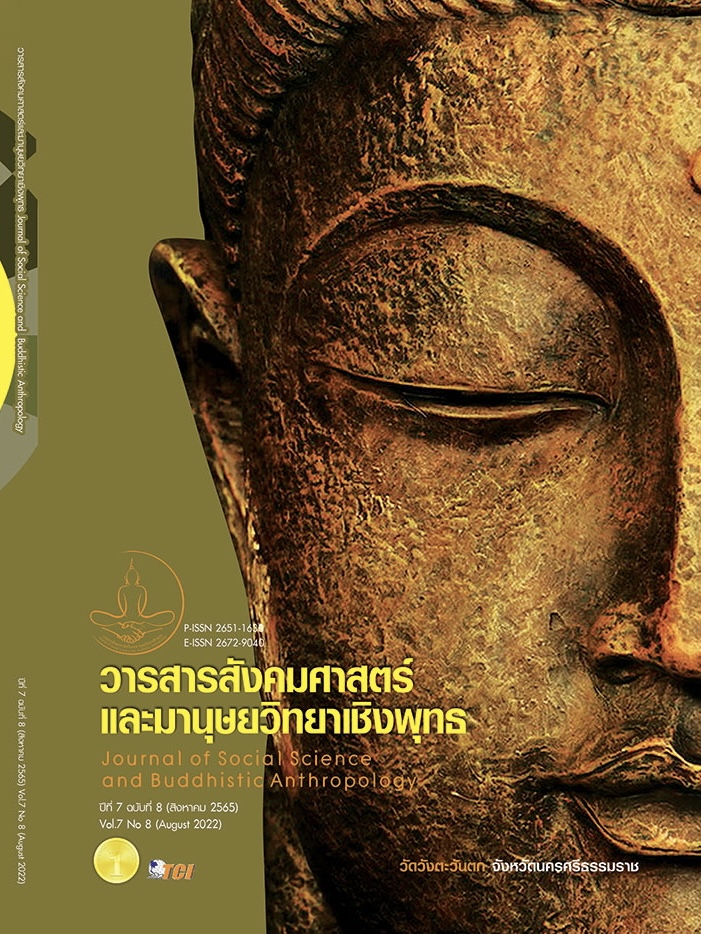THE EFFECTS OF RECREATIONAL DANCE MODEL TO ENHANCE CREATIVE THINKING AND INNOVATION FOR HIGHER EDUCATION STUDENTS
Keywords:
Recreation, Dance, Creative thinking, Innovation, Higher educationAbstract
The objectives of this research article were to; 1) Study the creative thinking and innovation of higher education students using the recreational dance model. 2) Study the quality of recreation dance innovation of higher education students. 3) Study the satisfaction of using the recreational dance model for higher education students. It was a quasi - experimental research. by studying with students at the higher education level at Rajamangala University of Technology Phranakhon.in the semester of the 2021 academic year consisted of 20 students by purposive sampling using a single group experimental model. The results were repeated at specified intervals several times before and after the experiment using the single group pretest-posttest time series design. The duration of the experiment was 10 weeks, at once a week for 50 minutes. The instrument used to collect the data was the Creativity Assessment form, Dance Innovation Evaluation form and the Satisfaction Assessment form for using this model. The statistics used to analyze the data were mean, standard deviation, One-way Repeated Variance Statistics (One-way Repeated ANOVA) The results were as follows. 1) The students had higher creativity skills than before the experiment. 2) The quality of dance innovation is very good. and 3) An overall satisfaction with using the model was at a high level. In addition, it was found that the students were most satisfied because the form of recreational activities in the form of dancing was fun. enjoy for learners It also helps to encourage learners to have more knowledge, skills and experience of dancing.
References
คณะกรรมการอิสระเพื่อการปฏิรูปการศึกษา. (2562). แผนการปฏิรูปประเทศด้านการศึกษา. กรุงเทพมหานคร: สำนักงานเลขาธิการสภาการศึกษา.
ชาญณรงค์ วิเศษสัตย์. (2562). การศึกษาองค์ประกอบ ความต้องการ และความจำเป็นในการส่งเสริมทักษะการคิดสร้างสรรค์ของนักศึกษาวิชาชีพครู. วารสารมนุษยศาสตร์และสังคมศาสตร์มหาวิทยาลัยธนบุรี, 14(1), 79-90.
ดารา ทีปะปาล และศิรชญาน์ การะเวก. (2561). รูปแบบพฤติกรรมความคิดสร้างสรรค์และนวัตกรรมของบุคลากรในองค์การธุรกิจของไทย. วารสารวิชาการ มหาวิทยาลัยกรุงเทพธนบุรี, 7(1), 108-194.
ธารทิพย์ ขัวนา และขวัญชัย ขัวนา. (2561). การจัดการเรียนรู้เพื่อส่งเสริมความคิดสร้างสรรค์เชิงผลิตภาพทางการศึกษา: สู่ยุคการศึกษาไทยแลนด์ 4.0. วารสารสถาบันวิจัยและพัฒนา มหาวิทยาลัยราชภัฏมหาสารคาม, 5(2), 325-342.
ไพฑูรย์ สินลารัตน์ และสมพงศ์ วิทยศักดิ์พันธุ์. (2561). บทบาทครูในการส่งผู้เรียนให้สามารถแข่งขันได้ในโลกแห่งศตวรรษที่ 21. (พิมพ์ครั้งที่ 2). กรุงเทพมหานคร: DPU Coolprint มหาวิทยาลัยธุรกิจบัณฑิตย์.
วรินทร บุญยิ่ง. (2558). ทุนมนุษย์ทางการศึกษา: แนวคิดและการปฏิบัติในศตวรรษที่ 21. กรุงเทพมหานคร: โอ. เอส. พริ้นติ้ง เฮ้าส์.
วัชรา เล่าเรียนดี และคณะ. (2560). กลยุทธ์การจัดการเรียนรู้เชิงรุกเพื่อพัฒนาการคิดและยกระดับคุณภาพการศึกษาสำหรับศตวรรษที่ 21. (พิมพ์ครั้งที่ 12). นครปฐม: เพชรเกษมพริ้นติ้ง กรุ๊ป.
วิชัย วงษ์ใหญ่ และมารุต พัฒผล. (2562). การพัฒนาทักษะสร้างสรรค์และนวัตกรรม. กรุงเทพมหานคร: ศูนย์ผู้นำนวัตกรรมหลักสูตรและการเรียนรู้.
สมาน อัศวภูมิ. (2558). ความคิดสร้างสรรค์และการจัดการเรียนรู้ที่ส่งเสริมความคิดสร้างสรรค์. BUABANDIT JOURNAL OF EDUCATIONAL ADMINISITRATION, 15(พิเศษ), 9-16.
สำนักคณะกรรมการการอุดมศึกษา. (2561). แผนอุดมศึกษาระยะยาว 20 ปี (พ.ศ 2561 - 2580). เรียกใช้เมื่อ 25 ตุลาคม 2564 จาก http://www.mua.go.th/users/bpp /main/download/plan/plan20yrs.pdf
สำนักงานเลขาธิการสภาการศึกษา. (2557). บทวิเคราะห์การศึกษาไทยในโลกศตวรรษที่ 21. วารสารวิจัยการศึกษา, 2(4), 1-3.
สำนักงานวัตกรรมแห่งชาติ. (2549). พลวัตนวัตกรรม. กรุงเทพมหานคร: สำนักงานนวัตกรรมแห่งชาติ กระทรวงวิทยาศาสตรและเทคโนโลยี.
สำนักงานสภาพัฒนาการเศรษฐกิจและสังคมแห่งชาติ. (2563). ยุทธศาสตร์ชาติ. เรียกใช้เมื่อ 8 มีนาคม 2564 จาก http://nscr.nesdb.go.th/wp-content/uploads /2020/09/Sep-full-v2.pdf
สำนักนันทนาการ. (2562). ผู้นำนันทนาการ. กรุงเทพมหานคร: โรงพิมพ์เอส.เอฟเซ็ทกราฟฟิคดีไซน์.
Dobbie, T. (2020). What is Dance about? Retrieved April 16, 2021, from https://ncea.education.govt.nz/arts/dance?view=learning
Shimizu, D. & Okada, T. (2021). Interaction between Action and Cognition in Creativity: Perception and Action-based Imagination (PAI) Framework. Proceedings of the Annual Meeting of the Cognitive Science Society. Retrieved April 16, 2021, from https://escholarship.org/uc/item/32r9j1sh
World Economic Forum. (2020). The Future of Jobs Report 2020. Retrieved April 16, 2021, from https://www.weforum.org/reports/the-future-of-jobs-report-2020/
Downloads
Published
How to Cite
Issue
Section
License
Copyright (c) 2022 Journal of Social Science and Buddhistic Anthropology

This work is licensed under a Creative Commons Attribution-NonCommercial-NoDerivatives 4.0 International License.








